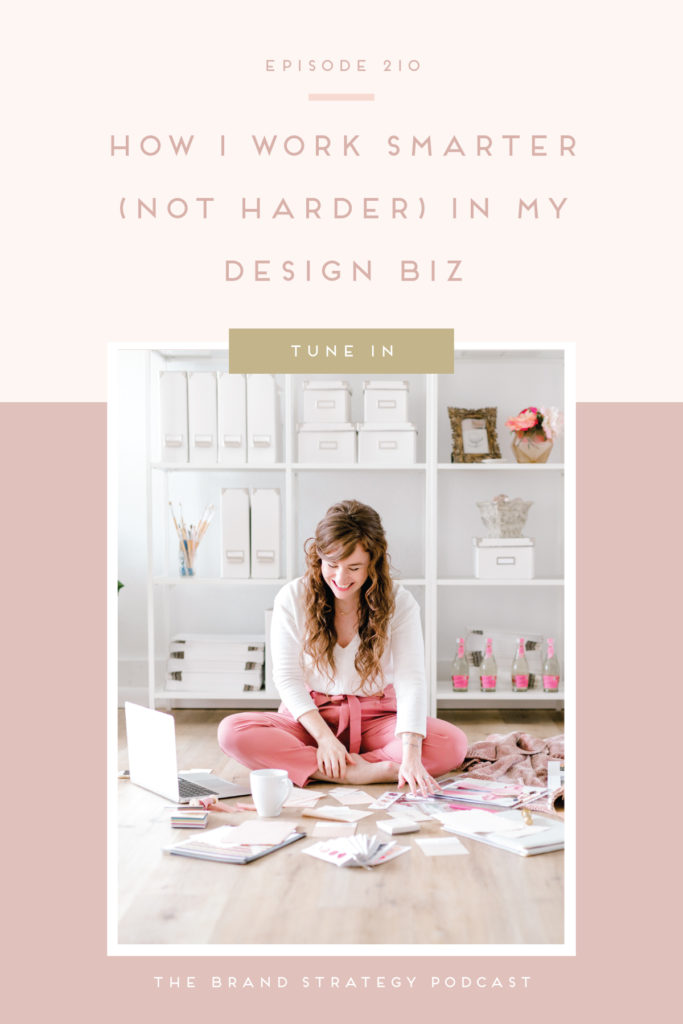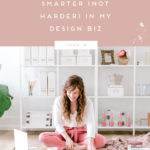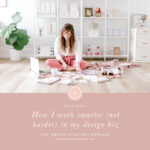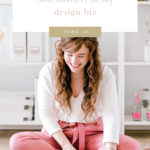Podcast: Play in new window | Download
Subscribe: Google Podcasts | Spotify | RSS

Are you getting caught up in tasks that aren’t moving your business forward? Maybe you’re not even aware that you’re doing it! After nearly a decade as a business owner, I’ve found a few ways that have allowed me to work smarter, not harder in my business! Listen in as I share how tracking your time, creating workflows, and utilizing automations in your business will help you do just that.
Now, if you’re dreaming of consistent monthly income without adding more to your already overflowing plate, fellow designer, then this free training is for you!
Working Smarter Not Harder in Your Business
As a designer who has worked on creating a streamlined business for nearly a decade, I’ve spent time and energy investing into ways that will help be work smarter in business. While I went into this with an open mind, I’ve found three very beneficial ways to work smarter, not harder that I believe every business owner should use.
Tracking Your Time
The first place you should start when streamlining your business is to know where you’re spending your time. Even after years of doing it, I still find so much value in tracking my time. It allows me to see how much of my time is revenue generating, how much time I spend marketing, how much time I’m working with students and clients, and so much more!
I simply use a tool, like Toggl, to track what I do in my business every single day, then I recommend reviewing on a quarterly or monthly basis. This will allow you to know where you need to optimize, adjust, and streamline your work. From there, I look at what workflows and automations I can create.
Following Workflows for Everything
In my design business, I have workflows for everything. From the different types of client services I offer to consult calls to onboarding. I’ve created a workflow for everything, but it hasn’t always been that way.
In the beginning, I was recreating the wheel each time I booked a new client. THis was creating more work on me than neccessary, so I streamlined it with a workflow for every single service.
You can do this by creating Standard Operating Procedures and Tutorials for team members with tools like loom. By doing this, you’re not having to think through what you’ll do next, but rather following a guide to best serve your clients.
Automations
The next optimization I use is automations. I’m able to free up more energy and mental space for me to show up as my best self for my clients. Automations can feel a little scary and hands-off, but when set up correctly, you free up that mental space to better serve.
You can automate so many things in your client management tool, like proposals, invoices, and even email communication! While you’re building out your workflows with your clients, consider what items in those workflows can be automated to take a little more work off your plate.
If you’re dreaming of consistent monthly income without adding more to your already overflowing plate, fellow designer, then this free training is for you!
Enroll in Brand Strategy School
If you’ve enjoyed this approach to working smarter, not harder in your business, then you’ll truly enjoy my Brand Strategy School. You can’t sustainably scale your design business by adding more to your already overflowing plate, so let me show you my blueprint to creating your dream design business and woo your ideal clients every time! Come join me in Brand Strategy School today!
FOLLOW ALONG
LIKE THE SHOW?
IN ORDER TO PROVIDE CONTENT YOU LOVE I WANT TO HEAR FROM YOU! SUBSCRIBE TO THE BRAND STRATEGY PODCAST AND LEAVE A 5-STAR REVIEW HERE. THE MORE REVIEWS, THE MORE I’M ABLE TO PROVIDE THIS FREE-ACTIONABLE CONTENT!

Review the Transcript:
Hi friend, and welcome to the brand strategy podcast. A show created to equip you with the inspiration, encouragement, and clarity. You need to build a brand of your dreams. I’m your host, Bonnie Bahktiari, brand designer, and founder of the Illume retreat from sustainable strategy to heartfelt encouragement. Each episode is designed to equip you with the tools you need to chase after your dreams, because you deserve a brand that empowers you to do what you love, connects with your dream clients and offers a deep sense of fulfillment along the way. So grab a cup of coffee and join the on this journey. Won’t you,
Hey friends, welcome back to the brand strategy podcast, where today we are talking about how I personally focus on working smarter and not harder in my design business. Now I am excited for us to have this conversation because in the years, yeah, 10 years, that’s crazy that I have been a designer and a coach for designers. I have really gone through, uh, a whole lot of trial and error. I have made all the workflow mistakes, and I have gone through like literal years of working smart, whatsoever. And so I’m excited to be able to share some of what I’ve learned so that I can hopefully save you time <laugh> so that you don’t have to go through the same trial and error that I did. You don’t have to make the same mistakes that I did and that together we can just fast track your growth in your design business, because I get it.
I know that you be working with your clients, the kind of people that you are so attracted to work with because you wanna serve them. Well, you want to use your design skills to help them, uh, really achieve their goals. And that brings you a deep sense of fulfillment and wasting your time in your inbox or struggling to like cobble together there, your workflows, when you’re onboarding a new client or off onboarding a client, that’s not where your time is best spent. So let’s get into it first step. I wanna share with you, uh, just a quick little disclaimer, this is what has worked well for me over the years, of course, take it with a grain of salt. Uh, we’re all different. We’re all unique. We all work in D ways. Our brains are these incredibly amazing, amazing things. And so we’re all different.
And I wanna honor that and I wanna respect that. So obviously what I’m saying is not the end all be all. If it resonates amazing take what works for you, if it doesn’t no worries whatsoever. And with that being said, I’m coming from a of, uh, having tried and tested these pieces of advice and these words of advice for years. So these are not things that I’ve just started doing. I have tested them, I’ve implemented them, I’ve refined them. And so I have a lot of data to back up where I’m coming from with this. So I hope that this is helpful. Now over the years that I have been working with designers specifically, and I have been working with them through my program for designers, the brand strategy school. And even back in the day when I used to do you one on one coaching, I know that workflows, and I know that time management.
And I know that this idea of working smarter and not harder in your design business can feel like a bit of a struggle for so many of us. We got into these businesses to create, to design, to cut, to sketch, to illustrate, to do so many incredible, incredible things. We don’t necessarily get into business because we are like time management experts or we are workflow aficionados or anything like that. So when we look at the component of man, our time in our businesses and streamlining things and maximizing our efficiency, this isn’t necessarily something that comes naturally to us and that’s okay. Right. That’s okay. So, uh, that’s why we get to talk about things like this, and we get to open up and share what works and what doesn’t. But in the years I have been running my own design business, working with clients one on one.
And even, even now in this season where I am working more and more with designers through educational offerings, these, these processes still apply. So let’s get into it. The first, the first piece of advice that I wanna share and the way it, I focus on really working more intentionally in my design business starts with something that might feel really elementary and not really very fun <laugh> but I promise you, it has been truly game changing for me. And that is tracking my time. So what I do is every single day, I use toggle track, which so many freelancers, so many teams use this tool. You can, there’s, there’s a free plan. That’s really robust. You know, there’s obviously paid options as well. There are also like probably hundreds, if not thousands of other programs or apps out there that can track your time for you.
But what I like to do is every single day, when I am sitting down at my computer and I am quote unquote, logging into work, I, I just start tracking my time. I say, okay, this is what I’m doing. I’m gonna spend 10 minutes on my, uh, morning, see a routine. Now I’m gonna spend, you know, 20 minutes checking, uh, Asana to see what’s happening. What projects are due, what progress is being made, what questions my team have for me and things like that. And I do that with everything. I categorize everything that I’m working on throughout the day. And yes, at first it was tedious because I had to remember, Ooh, I gotta do this. I gotta do that. One of the reasons why I like toggle track is because it detects. If you have the, I think it’s the extension or the, um, app on your computer, it can detect when you’re like changing, you’re doing something you’re like changing your behavior, going to do a new thing.
Uh, you’re opening a new window or something like that in your web browser. And so it can say like, Hey, do you want me to automatically track this? And I love that because I’m able to weekly, monthly, quarterly, and annually look at where my time goes. So at the end of the year, I sit down and I look at those reports and I look at where my time was spent. And that helps me truly decide in a way that is, is just 100% based on data and figures. Like I’m sitting there and I’m looking at how many hours of my life. I spent checking email or responding to messages and slack or recording reels for Instagram or, and things like that. And he gives me this incredible amount of insight into where my time is actually going. And then I get to have the autonomy and the power to say, okay, I wanted, you know, I’m fine with that.
Like, let’s, let’s keep doing that next year. Let’s do more of that. Or actually, Hey girl, no, that is not where I wanna spend my time. That is not how I wanna spend my energy. I gotta figure this out. This is where I am like leaking time. And I’m, I’m spending so much time doing this thing and it’s not, not really worth it, you know? And you can’t do that when you’re making assumptions. You can’t do that when you don’t have the data, you, you need to be able to track your time, to see where you’re actually spending your time, day in and day out. And like I said, it’s not glamorous. This is definitely not a sexy thing to do, but like, I just cannot stress enough how empowering it feels to be able to look at those reports. And I, I, again, like I get a weekly email in my inbox from toggle.
That’s like, okay, your weekly summaries here. And then, you know, monthly, I get to look back on it and, and you know, quarterly as well. And that helps me make very strategic choices about where my time is being spent, if that is worth it, how much of my time is going to revenue generating activities? How much of my time is going to things like marketing, how much of my time is going to working with current clients or with my students inside the brand strategy school. And so I’m able to, to make smart choices from that data. So if you’re not shocking your time, do it, trust me. It’s gonna change your life. You are not gonna believe how much time you spend in your inbox or how much time you spend in slack or, uh, how much time you spend in illustrator. It, it is genuinely mind blowing, but that’s a good thing because you know what knowledge is power.
And we like that around here. Okay. Step number two, that has been a big deal for me is following workflows for pretty much everything and workflows. I know we talk about this a lot, especially in the design industry, we’ve got workflows for everything, for how we design logos, to how we onboard clients, to how we talk with clients, to how we run our strategy meetings, to how, I mean, you know, I could just go on and on and on about that. Um, but where I really fell in love with workflows was years ago, I found myself in a season where I was pretty much recreating the wheel. Every single time I booked a new client, I was manually thinking about, okay, new client, they just signed with me. They just pay their deposit, what I would do next. Okay. I send them this email, this welcome email.
And then what do I do? Oh yeah, I get them their, um, their client onboarding workbook. And, you know, and, and the list just kind of went on and on and on. And I found myself, uh, thankfully I don’t think that I was letting you know, client experience fall through the cracks, but it was taking up so much active space in my brain. <laugh> that I was spending so much, I’m thinking about how to work with my clients, how to what’s the next kind of admin thing that needs to happen sort of thing. And I was taking up that valuable brain space that I could have, I could have spent on bringing more creative ideas into the design work that we were actually doing, or I could have used that energy, uh, that could have up through a conversation that we had or a call that we had or a meeting or something like that.
And that was a turning point where I realized if I’m ever gonna grow, if I’m ever gonna scale this business, I need to have these workflows written out. I need to be able to just follow them step by step by step. So there’s no guesswork. There’s no chance that I’m gonna forget anything that, you know, someone’s not gonna get their like client workbook, or they’re not gonna get their offboarding email, or I’m gonna forget to send the feedback form. Like it’s all gonna happen. And that happens when I remove the human error component or at least I try to remove it. So I like to follow this format where if I find myself doing a task and I’m doing it like two or three times, I need to figure out a way to document that workflow. And then I don’t need to think about it anymore.
So I’ve tried it a few different ways. One way you can document all of it in, uh, project manage management tool like Asana, or, you know, Google docs. You could record a little loom video. I’ve actually started recording a lot more loom videos because I have a, a small mighty team of incredible women who work alongside me and we’re all remote. And so getting to just shoot them a quick little message in Asana and saying, Hey, this is how we do this. If you ever need it has been very helpful. Uh, so again, kind of figure, it kind of boils down to, I guess, what works best for you. If you’re more visual loom videos where you’re like talking to yourself and saying like, okay, we do step one, step two, step three. Or if you’re the kind of person where you prefer to have those, those written SOPs, um, writing them out is really helpful.
And one of the reasons why I like doing this is because again, you can do this quarterly, you can do this annually. You can do it whenever you want, cuz it’s your business, but you can actually take a look at all of these workflows that you have and you can revisit them and assess whether they’re still working or whether they need some refinement. So a few years ago, uh, I was looking at, I think it was like my end of year review and I was reviewing all of our workflows and, um, SOPs. And I know that when we were getting new design inquiries, new branding, client inquiries, the workflow that we had been using, there was like one step in the middle of it that still required a person to like click send on that email. And I realized that that could be automated. That could be set up on an automation where after a certain amount of time am his past, that email is automatically sent.
And that would be such a simple fix. That means that that workflow is working exactly the way that we want it to, but a human doesn’t have to touch it. I don’t have to be in there. I don’t have to think about it. Um, and that doesn’t interrupt me from whatever else I’m doing, but I wouldn’t be able to, to do that if I didn’t know what my workflows were. So something to think about then the third and final piece that has been really powerful for me, that really actually goes hand in-hand with my workflows is automations. I use automations and I automate as much as possible so that I can free up more of my energy and more of my mental space to show up as my most energetic and compassionate human self that I can be for my clients. So I think that automations, some people can be a little intimidated by them because they’re like, Ooh, I don’t really wanna automate my whole client experience.
I don’t want for things to feel like it’s just, uh, you know, like happening on autopilot. And I get that. But what I personally like to do, the way that I’ve kind of worked around it is in, I don’t, I don’t automate a lot of my, a lot of my client experience pieces. What I do automate are, uh, things like onboarding are offboarding, or if we are kind of, if we’re signaling a shift within a client project. So this is for design projects specifically, if we’re going from say logo and identity design work to web design, or kind of moving into collateral design that transition, like get those, those pieces prepped, getting, you know, like the, the files all set up or the folders all set up like that can be automated. Right? And I do that so that I’m able to show up for my clients without worrying about the tech or worrying about the details.
And I’m able to show up 100% fully for them and for the relationship and for the work that we’re doing. And I’m able to have more of that mental space freed up so that I can be my most strategic self and that can shine through the design that I’m doing. And this is actually something that, uh, I also do with my incredible students inside the brand strategy school. So like when we have new students join the brand strategy school, I have some really simple automation set up that make them feel really welcome. So they’re getting emails like right when they join, they’re getting emails that are walking them through the course and pointing them towards how they can get support and how they can with me. And, you know, sort of that like all those next steps that are gonna really set them up for the best student experience inside the program.
And it means that I don’t need to be sitting there remembering to, okay, gotta add the newest student to this workflow. So they get these emails all automated so that I’m able to like show up in our private Facebook group and like just have so much energy to welcome them in, to start, to get to know them, to get, to hear their goals, get to like put our heads together and create a plan for how we’re going to take action to make this time together as powerful as possible so that they can experience consistently profitable months in their design business, using my done for you method that I teach inside the BSS. So automations, I really do believe, at least for me personally have been so key in allowing me to show up more fully. And with this sense of freedom to the people in my business, the relationships, the people that matter, and that’s transformative, that’s such a big deal be.
And it means so much to me. And I know it means a lot to them. So to quickly recap three things that have been incredibly useful for me, that I hope will be useful for you as well, tracking your time, knowing where your time is going, like seriously, every single minute of your work day, where is that being spent following workflows, getting those workflows down in the first place, documenting them, then that gives you the chance to follow through consistently, which improves the quality of your client experience. And you have the opportu to review and refine as needed. And then finally implementing some automations. My CRM honey book includes automations. I mean, a lot of CRMs do, you could use something like Zapier that integrates with like, gosh, thousands, thousands of different apps tools. There are so many ops out there. And what that means is you get to free up more of your active time and energy and brain space on revenue, generating activities or relationship building or ideation or vision casting and the things that really are amazing and so great in your business.
And hopefully spend less time thinking about, does that email need to go out to that new client that I just booked or did it already go out because I set up the automation. So friends, I hope that that is helpful. I hope that you have, why walked away with a tip or two or maybe three that are gonna help you refine the way that you’re working in your business so that you can stop really being, uh, the person’s running around in your design business, wearing all of the hats and you can let some tech and some tools help lighten the load a bit for you. And then you’re able to focus more on growing your design business and then scaling. So with that being said, if growing your design business and scaling in a way that doesn’t add more to your already overflowing plate, sounds like just what you’re looking for.
Then I want to encourage you to hop on over to my completely free training that I have created just for graphic brand and web designers on how to triple your income as a designer, without taking on more clients than you can actually handle. You can grab your access to that free masterclass@bsforbonniedesign.com slash training. And that is gonna walk you through the exact method that I use to take my business from struggling to sought after, without adding more to my plate without craming my schedule full of client work and without hustling to be seen by my ideal clients online. So, um, I’m so excited for you to head on over and check that out. And in today’s episode, I know I mentioned my private community for designers, the brand strategy school. And if you wanna learn more about that program, head on over to my website, you can click on the link in my site menu for designers, or you can just, uh, go to BS for Bonnie design.com/brand strategy school.
That is my signature program that you have lifetime access to when you join, that shows you how to generate consistent monthly income to the tune of 10 plus K, where you are connecting with your ideal clients, consist by leveraging a done for you brand strategy process, my exact brand strategy process that empowers you to charge more for your services, captivate the attention of your ideal clients and position yourself as an absolute pro. And we do all of this without any guesswork, no trial, or, and you’re able to implement this entire system and start booking clients at your new higher rates in as little as 30 days, which is absolutely amazing if you ask me, so if you wanna join me and the incredible group of designers we have over there, feel free to hop on over and check it out. And as always, if you have questions about anything that we covered today, or just wanna say, Hey, I always love connecting with you.
So feel free to hop on over to Instagram. It’s where you can find me the most often you can reach out to me at Bonnie to joy Marie, hang out in the DMS. And let me know if this resonated, or if you have any questions, if this is something that you have a designer friend who, you know, they could use a little pep talk around how they’re working smarter or not harder, and their design business feel free to pass along this link, because the more we share, the more that we get this out there, the more that we can show our fellow designers, how it’s possible to build a wildly successful business without directionless hustle and without trading your time for dollars. So friend as always, thanks for being a part of this little community, and I’m always cheering you on from wake up.
Thank you so much for joining me today, friend, before you go, I would be so grateful to receive your feedback on the brand strategy podcast. If you enjoyed this episode or the podcast in general has helped you grow your brand. I’d really appreciate it. If you left us a review in iTunes, your positive reviews enable the brand and strategy podcast to continue to grow and reach like-minded creatives. Just like you. Thank you for all your support and encouragement as together. We pursue building Brandson with purpose and intention until next time and cheer you on from Waco.





leave a comment